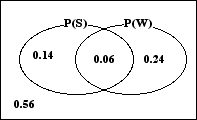1.
a. R and B are complementary.
b. R and B or H and B are mutually exclusive events.
c. R and B or H and B or H and R
d. P(K ![]() H) = 1/52 = 0.0192 (as there is only one King of Hearts.)
H) = 1/52 = 0.0192 (as there is only one King of Hearts.)
P(K) . P(H) = 4/52 x 13/52 = 0.0192
Because P(K
H) = P(K) . P(H) then the events are independent.
2. 
P(S ![]() W) = 0.2 x 0.3 = 0.06 (see diagram)
W) = 0.2 x 0.3 = 0.06 (see diagram)
a.P(raining in either S or W) = P(S
W) = 0.14 + 0.06 + 0.24 = 0.44
b. P(raining in S but not in W) = 0.14
3.
a. P(raining in either S or W) = 0.44
b. P(raining in S but not in W) = 0.14
4.
(i) a. Independent events are events where if one occurs, it makes not difference to the probability of the other occurring.
The probability of all of the events occurring is the product of all of the separate probabilities.
b. Disjoint events are events that cannot happen at the same time. If events A and B are disjoint then P(A ![]() B) = 0
B) = 0
(ii) Two events cannot be both independent and disjoint (unless the probability of one event is zero.)
5. 0.00548 (to 3 s.f.)
6.
(i) The events are not independent as P(A ![]() B) is not equal to P(A) x P(B)
B) is not equal to P(A) x P(B)
(ii) The events are not mutually exclusive as P(A ![]() B) is not equal to 0. i.e. There is some overlap of the two events.
B) is not equal to 0. i.e. There is some overlap of the two events.
(iii) P(A ![]() B) = 0.52
B) = 0.52
7.
(i) P(A ![]() B) = P(A) + P(B) − P(A
B) = P(A) + P(B) − P(A ![]() B)
B)
P(B) = 0.6
(ii) Because P(A ![]() B) is not equal to P(A) x P(B) the two systems are not statistically independent.
B) is not equal to P(A) x P(B) the two systems are not statistically independent.
8.
(i) P(he/she uses calculator) = 0.53 (to 2 sig.figs.)
(ii) P(owns calculator but does not use it regularly) = 0.04 (to 2 sig. figs.)
(iii) P(does not own a calculator) = 0.21 (to 2 sig.fig.)